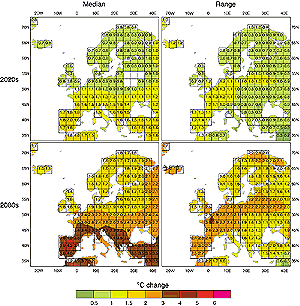13.5.2.2 Defining climate change signals
The question of signal-to-noise ratios in climate model simulations was alluded
to above, and has also been discussed in Chapters 9 and
12. The treatment of “signal” and “noise”
in constructing climate scenarios is of great importance in interpreting the
results of impact assessments that make use of these scenarios. If climate scenarios
contain an unspecified combination of signal plus noise, then it is important
to recognise that the impact response to such scenarios will only partly be
a response to anthropogenic climate change; an unspecified part of the impact
response will be related to natural internal climate variability. However, if
the objective is to specify the impacts of the anthropogenic climate signal
alone, then there are two possible strategies for climate scenario construction:
- attempt to maximise the signal and minimise the noise;
- do not try to disentangle signal from noise, but supply impact assessments
with climate scenarios containing both elements and also companion descriptions
of future climate that contain only noise, thus allowing impact assessors
to generate their own impact signal-to-noise ratios (Hulme et al., 1999a).

Figure 13.8: A summer (JJA) temperature change scenario for Europe
for the 2020s and 2080s. Left panel is the median scaled response of five
GCM experiments available on the IPCC Data Distribution Centre (http://ipcc-ddc.cru.uea.ac.uk/)
and the right panel is the inter-model range (largest scaled response minus
the smallest scaled response). (Source: Hulme and Carter, 2000.) |
The relative strength of the signal-to-noise ratio can
be demonstrated in a number of ways. Where response patterns are reasonably
stable over time, this ratio can be maximised in a climate change scenario by
using long (30-year or more) averaging periods. Alternatively, regression or
principal component techniques may be used to extract the signal from the model
response (Hennessy et al., 1998). A third technique is to use results from multi-member
ensemble simulations, as first performed by Cubasch et al. (1994). Sampling
theory shows that in such simulations the noise is reduced by a factor of  (n),
where n is the ensemble size. Using results from the HadCM2 four-member ensemble
experiments, Giorgi and Francisco (2000), for example, suggest that uncertainty
in future regional climate change associated with internal climate variability
at sub-continental scales (107 km2), is generally smaller
than the uncertainty associated with inter-model or forcing differences. This
conclusion is scale- and variable-dependent, however (see Chapter
9, Figure 9.4; see also Räisänen,
1999), and the inverse may apply at the smaller scales (104 to 105
km2) at which many impact assessments are conducted. Further work
is needed on resolving this issue for climate scenario construction purposes. (n),
where n is the ensemble size. Using results from the HadCM2 four-member ensemble
experiments, Giorgi and Francisco (2000), for example, suggest that uncertainty
in future regional climate change associated with internal climate variability
at sub-continental scales (107 km2), is generally smaller
than the uncertainty associated with inter-model or forcing differences. This
conclusion is scale- and variable-dependent, however (see Chapter
9, Figure 9.4; see also Räisänen,
1999), and the inverse may apply at the smaller scales (104 to 105
km2) at which many impact assessments are conducted. Further work
is needed on resolving this issue for climate scenario construction purposes.
A different way of maximising the climate change signal is to compare the responses
of single realisations from experiments completed using different models. If
the error for different models is random with zero mean, then sampling theory
shows that this model average will yield a better estimate of the signal than
any single model realisation. This approach was first suggested in the context
of climate scenarios by Santer et al. (1990) and is illustrated further in Chapter
9, Section 9.2.2. Treating different GCM simulations
in this way, i.e., as members of a multi-model ensemble, is one way of defining
a more robust climate change signal, either for use in pattern-scaling techniques
or directly in constructing a climate scenario. The approach has been discussed
by Räisänen (1997) and used recently by Wigley (1999), Hulme and Carter
(2000; see Figure 13.8) and Carter et al. (2000b) in providing
regional characterisations of the SRES emissions scenarios.
The second strategy requires that the noise component be defined explicitly.
This can be done by relying either on observed climate data or on model-simulated
natural climate variability (Hulme et al., 1999a; Carter et al., 2000b). Neither
approach is ideal. Observed climate data may often be of short duration and
therefore yield a biased estimate of the noise. Multi-decadal internal climate
variability can be extracted from multi-century unforced climate simulations
such as those performed by a number of modelling groups (e.g., Stouffer et al.,
1994; Tett et al., 1997; von Storch et al., 1997). In using AOGCM output in
this way, it is important not only to demonstrate that these unforced simulations
do not drift significantly (Osborn, 1996), but also to evaluate the extent to
which model estimates of low-frequency variability are comparable to those estimated
from measured climates (Osborn et al., 2000) or reconstructed palaeoclimates
(Jones et al., 1998). Furthermore, anthropogenic forcing may alter the character
of multi-decadal climate variability and therefore the noise defined from model
control simulations may not apply in the future.
|